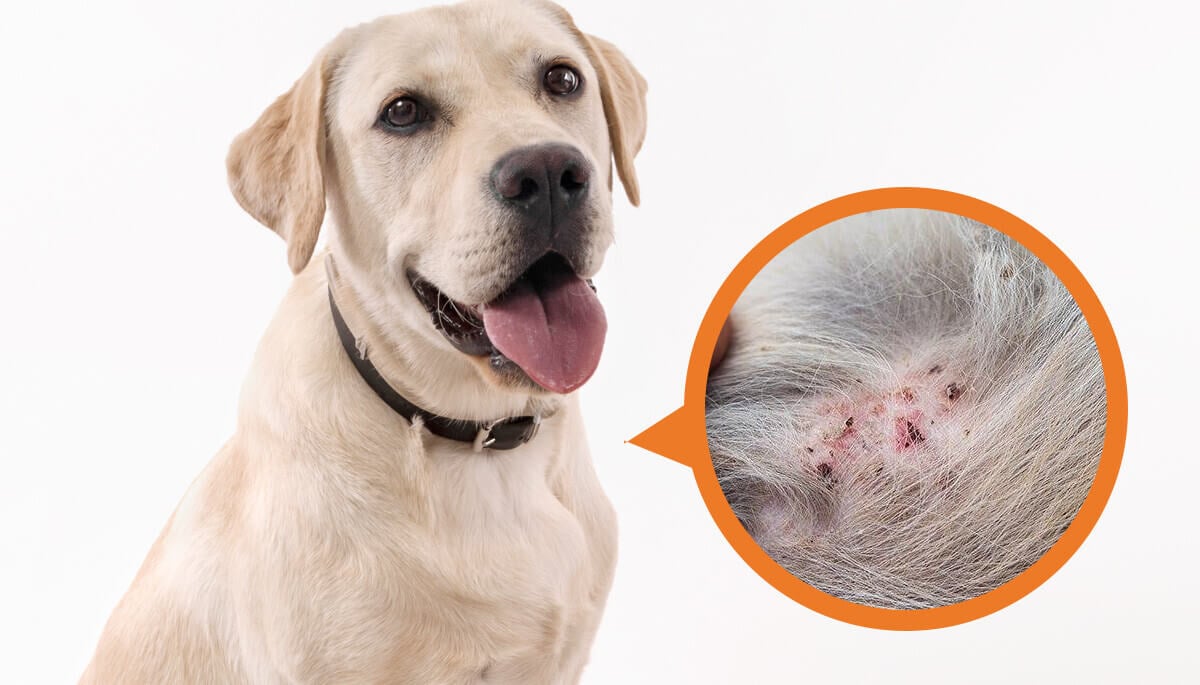Folliculitis in dogs is a common skin condition that affects many pets, leading to discomfort and distress if not treated promptly. This article will delve into what folliculitis is, how to recognize its symptoms, understand its causes, and explore both medical treatments and preventative measures to keep your pup healthy and happy.
To make sure we give you the best information possible on the topic, we have consulted the work of veterinary dermatologists Dr. Rosanna Marsella and Dr. Hilary Jackson. So, let’s delve in.
So, What is folliculitis in dogs?
Canine folliculitis is when the dog’s pores or hair follicles become inflamed and infected, usually by Staphyloccocus bacteria. It can happen anywhere on a dog’s body, but it is most common on the face, between the toes, on the belly, and under the armpits.
Folliculitis in dogs is common in dogs with almost any recurring skin problems. If your dog has allergies, is prone to yeast infections or hot spots, has ingrown hairs, or suffers from rashes, they may have folliculitis too.
Folliculitis is also one of the most common symptoms of dog pyoderma, along with pimples and black scabs. It is called Superficial pyoderma or bacterial folliculitis because it doesn’t reach deep into the skin. Instead, it stops at the hair follicle. It is very similar to sebaceous cysts on dogs.
It is not the same as ingrown hair or impacted hair follicle, although these can become folliculitis if it causes an infection. Essentially, folliculitis happens when the hair follicle is damaged, or there is a change in the environment that lets bad bacteria or fungi grow rampant.
Unfortunately, it is becoming harder to treat because the Staph bacteria strains are becoming resistant to antibiotics. This can cause complex infections, where the condition is recurring, as opposed to simple infections, which only happen once, like after a flea infestation.
But how do we know what folliculitis looks like?
Folliculitis in Dogs Signs & Symptoms
Folliculitis is usually a cluster of hard red bumps. They may contain pus, and you typically see them on soft, mostly hairless parts of the dog’s body, like the belly, armpits, and groin.
In light-colored dogs, you may see the skin redden in certain areas, such as between the paw pads or around the genitals. There may be a musty odor. This is usually a sign of a yeast or fungal infection. You may also see impacted hair follicles in this area.
Typical signs of infected hair follicles are:
- Red, swollen lumps;
- Pimples;
- Hyperpigmentation;
- Bumps all over the dog’s skin that look like hives
- Nodules or papules;
- Circular areas where the hair falls out with scabs or crusts called epidermal collarettes;
- Leaking discharge;
- Pain or itching; and
- Blackheads.
What Causes Folliculitis in Dogs?
There are many different “types” of folliculitis. These include:
- Chin Acne;
- Skin-fold pyoderma in dogs like Shar Peis and Bulldogs;
- Infected follicles in broken skin calluses on pressure points like elbows;
- Oily seborrhea and sebaceous cysts;
- Breed-specific skin conditions like lip fold pyoderma in Spaniels or German Shepherd Pyoderma; and
- Allergic rashes.
Essentially, there are several basic root causes.
1. Superficial Pyoderma or Bacterial Folliculitis
Most kinds of folliculitis start from bacterial skin infections from Staphylococcus bacteria. They are opportunistic and tend only to infect a healthy hair follicle after trauma because the hair or skin was damaged or because of moist, warm conditions that allowed bacteria to proliferate.
2. External Parasites
Demodectic mites can infect the follicles and cause folliculitis. Dogs who scratch flea or other insect bites may also aggravate the skin.
3. Fungal Infections
Ringworm and yeast infections can directly or indirectly cause inflammation in the hair follicles.
4. Underlying Conditions
Dogs suffering from allergies often cause bacterial infections, as scratching can break the skin. So allergies are one of the major causes in any kind of dermatitis or skin issue.
However, dogs with weakened immune systems from stress or autoimmune problems often develop pustules and inflamed skin. Lupus or Pemphigus are sometimes the culprits.
Endocrine problems like Cushing’s disease and hypothyroidism are major causes of pyoderma and folliculitis, especially in older dogs.
Are Some Breeds More Prone to Folliculitis?
In general, purebred dogs are more prone to pyoderma and, by extension, to folliculitis. However, some dog breeds are more prone to certain kinds of infection, and others are more prone to certain underlying causes.
For example, dogs with short, bristly hair, like Pit Bulls, Shar Peis, Great Danes, and Bullmastiffs, are more prone to folliculitis between the toes and acne.
Dogs with loose skin and skin folds are likelier to have folliculitis from skin fold pyoderma.
German shepherds can get pimples and folliculitis from German Shepherd Pyoderma, while rough-haired terriers get blackheads and folliculitis on their back from Schnauzer Comedo Syndrome.
Breeds like the Golden Retriever, Doberman Pinscher, Schnauzer, and Dachshund have higher chances of hypothyroidism. Meanwhile, Chow Chows, Bulldogs, Akitas, and Labradors are all more vulnerable to Cushing’s syndrome.
This means many purebred dogs have some genetic predisposition that could lead to pyoderma and folliculitis.
How Do You Treat Folliculitis in Dogs?
So, let’s look at common treatments for canine folliculitis.
- Firstly, your dog needs to examine your dog to determine the cause of folliculitis. They will need to prescribe effective antibiotics for this resistant bacteria if it’s bacterial. They may need skin scraping or biopsies to determine the cause. A vet should also look for underlying health issues like Cushing’s disease.
- Your vet prescribe medicated shampoo for folliculitis in dogs. This will usually be a benzoyl peroxide treatment that can dry your dog’s skin out, so use a good moisturizer and aloe vera or oatmeal skin treatment afterward.
- Your vet may also give you topical treatments for the inflammation.
- Speak to your vet about adding about 20 mg per pound of body weight of EPA to your dog’s diet. EPA is an anti-inflammatory omega-6 fatty acid you can only get from fish or krill oils. It is great to restore and soothe the skin barrier. It is also is best given with vitamin E. About 300 IU a day has shown good results.
- Be proactive about treating any underlying health conditions like allergies, hypothyroidism, Cushing’s disease, autoimmune disease, or obesity. Managing these issues will limit folliculitis.
- Apply paw balm on the rough edges of the paw pads and elbow calluses to soften the skin.
Never pop or scrub the pustules or red bumps from folliculitis. Since these skin infections occur when the
Using Carbonated Water To Treat Folliculitis in Dogs
A cool study found that giving dogs with follicular skin infections (caused by a specific germ called Staphylococcus pseudintermedius) a bath in fizzy carbonated water, like the carbonated water we sometimes drink, could really help them get better. They took 19 dogs with this skin issue and split them into two groups. One group got baths in this bubbly water, and the other group just had regular tap water baths. They did this three times over two weeks.
Guess what? The dogs that got the fizzy water baths started to look and feel better much faster than the ones who just had plain water baths. Plus, the fizzy water made their skin a bit more acidic, which is a good thing because the pesky germs causing the infection don’t like acidic environments. But when they checked if the fizzy water directly stopped the germs from growing, it didn’t make much difference compared to plain water.
The best part? None of the dogs had any bad reactions to the fizzy water baths, making it a cool and safe way to help dogs with these annoying skin infections. So, if your dog is dealing with a similar issue, a fizzy water spa day might just do the trick!
Folliculitis in Dogs Treatment at Home: Beware Home Remedies for Skin Infections
The long-standing internet trend of applying baking soda, apple cider vinegar (ACV), or coconut oil for any dog health issue shows no signs of fading. So, to be clear, do not use apple cider vinegar for folliculitis in dogs or pyoderma. It will not work, and it may make things worse.
The idea that ACV works for pyoderma or folliculitis has no basis in any research or studies. The only possible connection is one study showing that if you put ACV solutions in a petri dish with bacteria and candida, it does kill it.
But a petri dish is not the same as your dog’s skin, which does not translate into medicine.
Before putting ACV on your dog’s skin, remember the following:
- Dog’s skin is naturally alkaline, and adding an acid does not “balance the PH”; it disrupts it.
- Using homemade treatments like ACV without going to the vet means your dog may not get the correct medicine for their condition. They may need antibiotics or antifungal medication, depending on the diagnosis. They may also have a serious underlying health problem that needs treatment.
- Supposing an ACV solution is the correct strength to kill harmful bacteria or fungi, keep in mind it will also kill the good bacteria your dog needs for healthy skin. This means skin health is still compromised.
How to Prevent Folliculitis
Step 1: Protect Your Dog Against Endocrine Disorders
Step 2: Protect Your Dog’s Immune System
Step 3: Manage Your Dog’s Environment
Step 4: Keep Up With Their Anti-Parasitic Treatments
Step 5: Be Careful With Grooming
Is Folliculitis in Dogs Contagious to Humans?
Dogs can have different kinds of folliculitis. Parasites like ringworm or mange are highly contagious and can infect humans. However, most pyodermic infections are not a threat to people.
Final Thoughts
Folliculitis is a fairly common condition, usually superficial bacterial folliculitis of pyoderma in dogs. It simply means that there is inflammation in the hair follicle.
However, the causes of this skin condition vary greatly. And it can take many different shapes. It can be infected with red impacted hair follicles around the genitals or between the toes. Or, it can be chin acne on a dog that slobbers a lot.
Folliculitis also often has serious causes, so always take your dog to the vet for a check-up, and avoid home remedies like apple cider vinegar.











